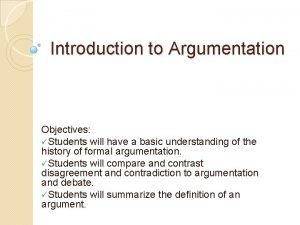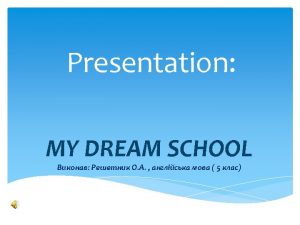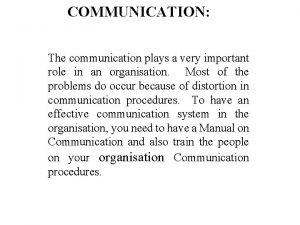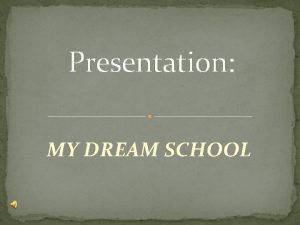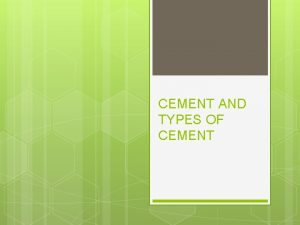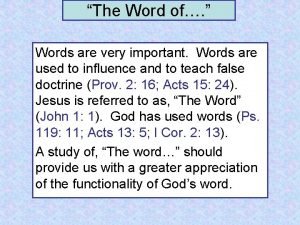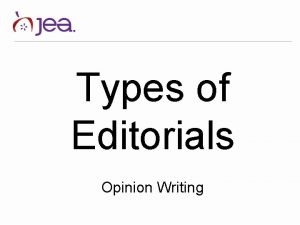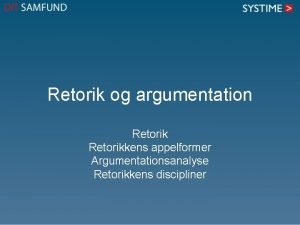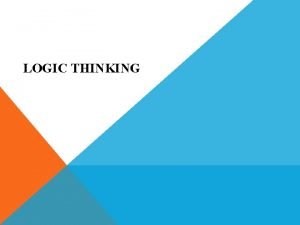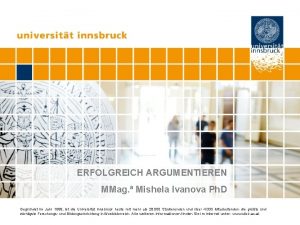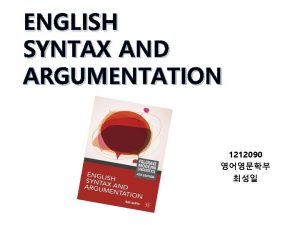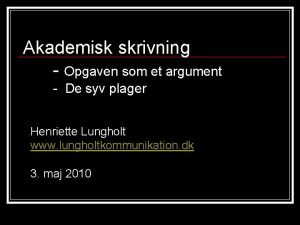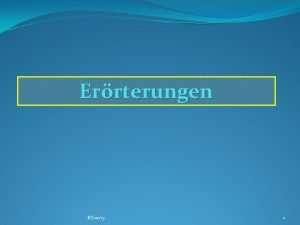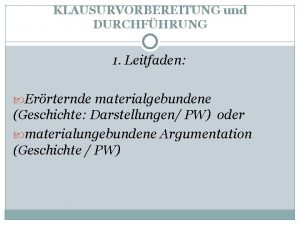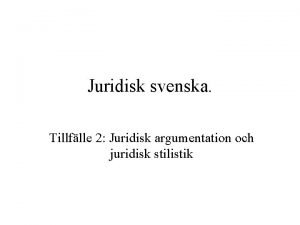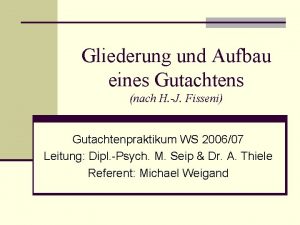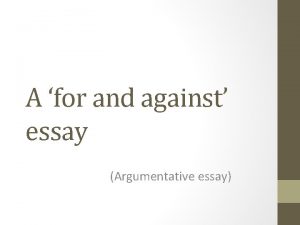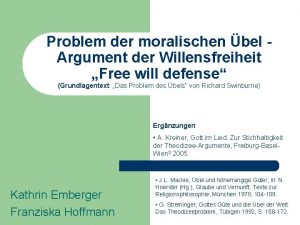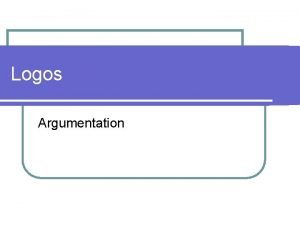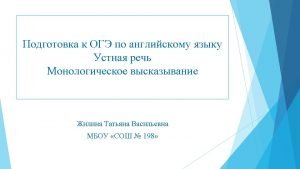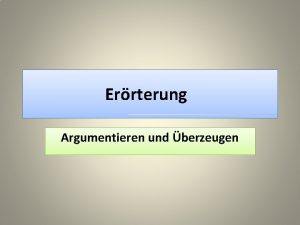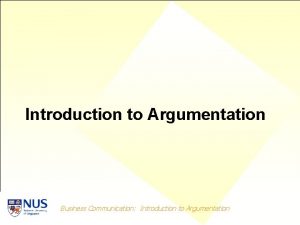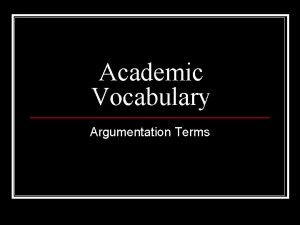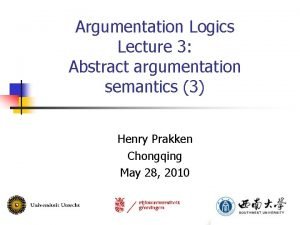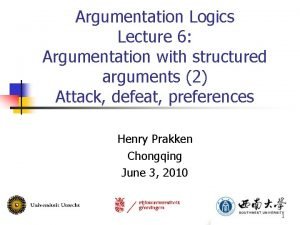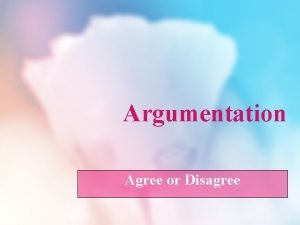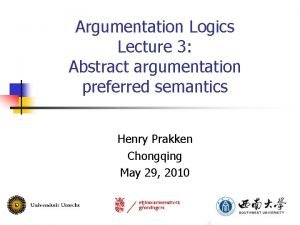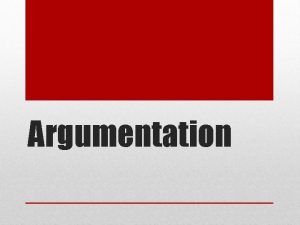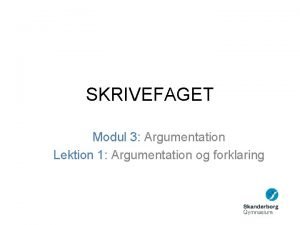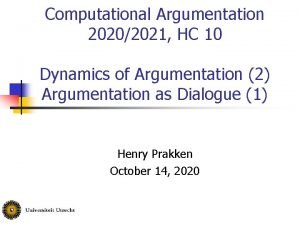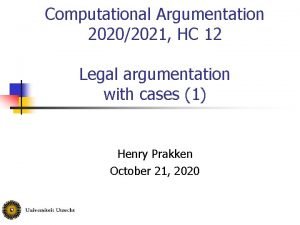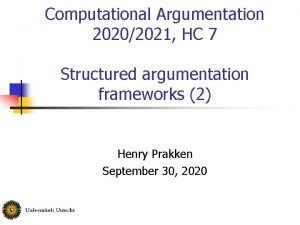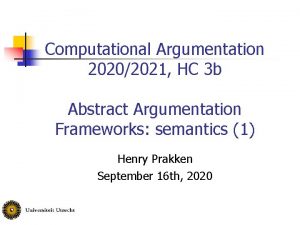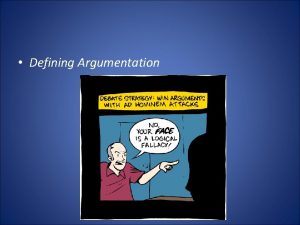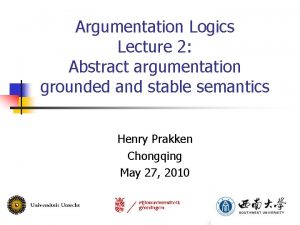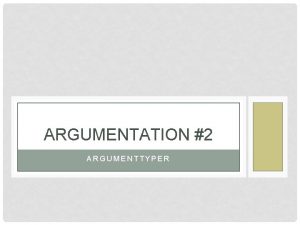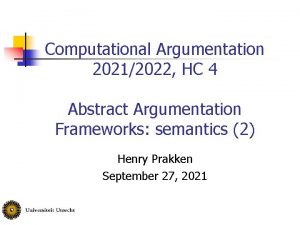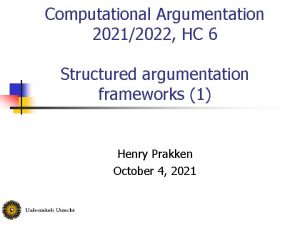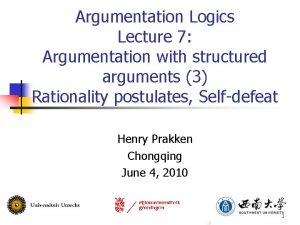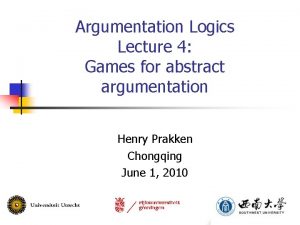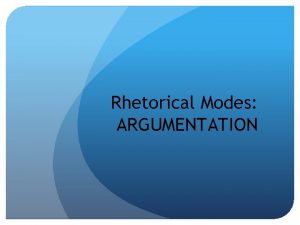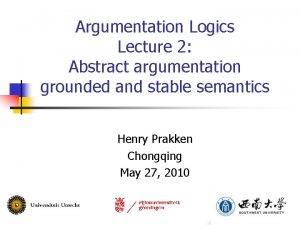ARGUMENTATION 1 0 INTRODUCTION Argumentation is very important



































- Slides: 35

ARGUMENTATION

1. 0 INTRODUCTION • Argumentation is very important verbal and writing communication. • Either YES or NO, it needs justification. “Argumentation comes into play when you and those with whom you are communicating become interested in justifying claim. ” (Malcolm, 1992) • Justification uses language, and should be systematic, easy to understand without misinterpretation. • It also should be logic and convincing.

Example: A: My favorite hobby is fishing B: Why do you like fishing? A: Because it can be done at leisure. B: Then reading, drawing, watching TV and gardening, can also be done as your hobby? A: Fishing is not the same as reading, drawing, watching TV and gardening B: Why it is not the same? A: Of course it is not the same. . How can they have similarity… bla. . bla!!

2. 0 DEFINITION • Set of statement that must be proven. “Argumentation as the advancing, supporting, criticizing, and modifying of claims. . ” (Richard & Malcolm, 1992)

“A form of thinking that using a particular statement in support of other statements (conclusions). ” (Chaffe, 1990) “A set of sentences consisting of an assertion to be support and the verbal evidence for that assertion. ” (Salmon, 1995).

“A claim that something is due to something else. ” (Ainon and Abdullah, 1996 )

3. 0 SYNTHESIS ØVerbal or writing communication. ØTrue and false statement. ØFacts and information. ØInductive and deductive logic. ØProduce a conclusion.

Argumentation could be happened in formal (speech and debate) and informal (chatting). It also could become a conflict.

4. 0 CRITICAL QUESTION 1. What is the main idea? 2. What is the evidence (books, studies, research) that support your argument? 3. Find the best evidence to persuade the audience?

4. What is kind of reading that can sharpen your argument? 5. What kind of values or beliefs that you hold through your argument?


5. 0 CATEGORY 1. Writing Argument The argument that was written and disseminated through printed and electronic media such as books, magazines, journals, newspapers and the Internet (John, 1991). If the argument is weak argument, it might be easily opposed by other parties.

CATEGORY 2. Verbal Argumentation It should be logic and systematic. However, majority of verbal argumentations are irrational and without logic. It much depends on knowledge, training and experience. Related career: Judge, lawyer, prosecutors, salesman, teachers, lecturers and others.

6. 0 EFFECTICE ARGUMENTOR • Fair and balanced in arguing Correct the doubtful statement. We also must be willing to be corrected if we make mistake. • Open-minded Widely open mind, accept all the arguments without prejudice even if contrary to our belief, do not disrupt the opponent's argument, give them time to present his argument. • Have a detailed knowledge of the issues debated It is important to provide a face of the opponent's counterarguments

• Ability to ma nipulate the o pponent's mistakes The error argu ment made by opponents can be used to fi Therefore nee ght back the argument. d to be a good listener. • Avoid Fallac y Fallacy offense s argued that d ue facts, data, exa mples, evidenc to the e etc. that is not true. This e rr does not apply or caused the argument and rejected th itself. e argument • Analyze the opponent/aud ience Need to do de mographic ana lys opponent/aud ience that we a is of the re better prepared, by p roducing relev ant arguments.

• Possess good communication skills The skills can be obtained from the education, experience, interaction, training, environment etc. • Self-calm and balanced personality Assertive, proactive and patient.


7. 0 SOURCES • Need to know how to acquire the knowledge and information by using the right resources and materials; – Self study; books, journals, reports, etc. – Experience. – Interview. – Attending seminar, discussion, workshop etc.

8. 0 KEYWORDS g n i d n dersta n u y b s ment u g r a e h t g n i Analys words: the key ) s n o s a e r ( s s e a s i e s m i e r m e p r n p o e s h t d r h o t i w w ” s … n f i g o e 1. Key n b o t s n a e e r Statem because, by , n s e o n s h o t i a s e h u t l i “r c w n s o n c i g n e o b s n d r o i o s s i w u h l t y c , e n e r o c o f f 2. K e o r t e n h t e , m y l e e t t a Sta m i t l u ” , o … s n “ o i s s u l c n word o c e h t s uggest

9. 0 CRITICAL THINKING PERSPECTIVE • Argument is an important element in critical thinking. It is not just giving opinions on an issue, but it is also necessary logic. It involves the ability to speak, the ability to convince people, new facts, interpret information, and so on.

Much involves on cognitive process, perception and interpretation. 1. Communication skills Either in proposing or opposing argu ment. 2. Reasoning skills The ability to give meaning, conceptu alisation, forming a more accurate picture of what is abstract, probing underlying issues, and thinking is an intellectual (Abdul Rah im, 1999)

/ s t s l c l a i f k s / s g a n it i e t d m e i r b p u w r s e 3. Inte bility to revi categories, he The a tion, create o produce t t a , m n r o o s d f a e in e t r n e d s n e a r s p n f o o s ity rea d i l a v d n a h t u tr. s t n e ls l i k s argum n io y l t l c a u u d s e u ( d t d n n e a m n u d o g i e r t i l a c p u n p 4. Ind an inductio tural and a l a a i n i c n o s f l s l o. g e. Ski n e i l ( p s i c n s o i i t d c e u h d e d in t d n a ) s e c n e sci

5. Ability to make inference (generalisation) Making inference in order to make decisions based on the existing statement. 6. Research skills Research with authentic and real data is able to support the presented argument concretely.


10. PURPOSES 1. Decision making Argument is used to make decision with certain reasons; e. g. X would like to marry with Y as X has to construct strong argument to his parents why he chose Y among million of girls. 2. To explain The argument used to explain to other people, such as speakers, lecturers, preachers, etc.

3. To predict Prediction could be made with concrete arguments. 4. To persuade means to influence feelings and emotions of other person as to motivate him for certain effort or action, by solid argument.

5. Strengthen the interpretation 6. To correct misconceptions Misconceptions can be corrected by presenting the argument correctly; no bias, dignity, truth and justice. 7. Strengthen support Strong and authentic argument enable to strengthen support as commonly happened in politics, judiciary, business (pitching etc. ) etc.

11. FORMS • Deductive Commonly used in social sciences as by politicians and lawyers. • Inductive Commonly used in natural and applied sciences as by scientists, to produce theory and law.

12. ARRANGEMENT • Common arrangement PREMISES CONCLUSION Example: All warm-blooded animal is a mammal, rats are warm-blooded animals (the premises), so the rat is a mammal (the conclusion).

• 2. Inverse arrangement CONCLUSION PREMISES Example: Inflation is a calamity to be avoided (the conclusion). Inflation not only leave a bad effect on society, it can bring the nation become bankrupt (the premises).

13. ARGUMENT EVALUATION • 1. True statement depends on the submitted facts and data. Incorrect fact/data; e. g. UFO was landing at city centre. Fact/data is only true in certain context; e. g. Italian is romantic and aesthetic while Japanese is hard working. Fact /data is no longer relevant; e. g. Malaysia recorded a GDP growth of 8% in 1997. Fact/data that is not true at all; e. g. all of the poison are food, all kind of love is blind love, all of blind people can not read.

e h t f o e r u t c u r t s d n thod a 2. Me t n e e h m t u , g e r u a r t e r a s e s i m e r p e h t f i , y Usuall. e u r t o s l a s i a t n a o d i s t u n l a c v e l con e r d n a e iv s n e h d e n r a p t c m a o f C y b 3. d e t r o p p u s s i t t n e m m u g u r g a r a , a t a Good d d n a t c a f t u o h n o d e s a b data. Wit s i t a h t n o i n i p o s e m o bec. e n o l a n perceptio

14. FALLACY • Fallacy is a weak argument and can not be accepted. Premises means that we use to support the conclusion is not true. It shows there has been a mistake in the way we think. As long as critical thinking based on logic, then it must comply with the regulations valid logic. If not, the argument is weakened and can be refuted by others. Fallacy can occur due to a false impression of our environment, so the premise that we use to infer the false and untrue in terms of legal logic. For example, the Malaysian team can beat Brazil in a football game. May be due to a sense of fanaticism, then we say that the quality of Malaysian football has reached the world level, whereas we know about Malaysia's position on the FIFA ranking.

15. CONCLUSION Argumentation is important in communication skills to convince the audience or the public on an issue being discussed. However there are things that can be contended and not to be contended. For example, matters pertaining to mutual agreement, religion can not be contended that it involves 'confidence and faith'. But for things that can, the argument is highly encouraged as it builds its critical and analytical thinking.

 Introduction to argumentation
Introduction to argumentation Very bad to very good scale
Very bad to very good scale Multiplication of scientific notation
Multiplication of scientific notation Very little or very few
Very little or very few Receiving table/area
Receiving table/area Quantifiers with food
Quantifiers with food School is very important
School is very important _is the very important function in the radio telex system.
_is the very important function in the radio telex system. Communication plays a very important role in
Communication plays a very important role in Your smile is important to us
Your smile is important to us Dream school assignment
Dream school assignment My cty
My cty Hi im a dog
Hi im a dog In cement hardening process instants are very important
In cement hardening process instants are very important Very important words
Very important words Example of a news story
Example of a news story Inverted pyramid in news writing
Inverted pyramid in news writing Least important to most important
Least important to most important Four types of editorials will
Four types of editorials will Argumentation og retorik
Argumentation og retorik Deductive logic definition
Deductive logic definition Induktive und deduktive argumentation
Induktive und deduktive argumentation English syntax and argumentation 연습문제 답
English syntax and argumentation 연습문제 답 Forvægt og bagvægt
Forvægt og bagvægt Tierversuche argumentation
Tierversuche argumentation Erörterung ping pong prinzip
Erörterung ping pong prinzip Argumentation einleitung
Argumentation einleitung Juridisk argumentation
Juridisk argumentation Aufbau eines gutachtens
Aufbau eines gutachtens For and against essay
For and against essay Argumentation
Argumentation Free will defense theodizee
Free will defense theodizee Logos argumentation
Logos argumentation Linking words for arguments
Linking words for arguments These beispiel argument
These beispiel argument Essay structure
Essay structure
